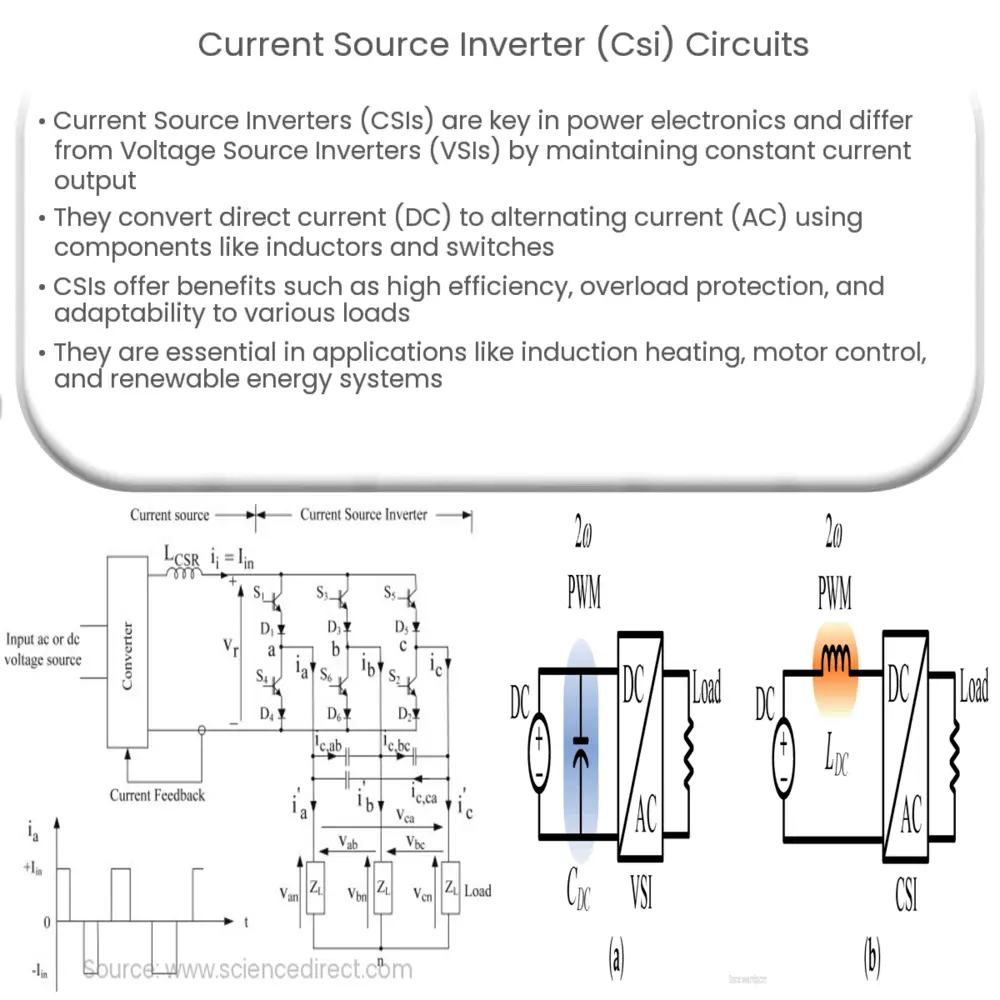Explore the intricacies of Current Source Inverters (CSIs), their advantages, applications, and significance in power electronics.

Introduction to Current Source Inverter (CSI) Circuits
A Current Source Inverter (CSI) is a vital component in the world of power electronics, particularly with regards to converting energy. CSIs stand as a contrast to their counterpart, the Voltage Source Inverter (VSI), providing a unique set of benefits and applications.
Understanding Current Source Inverters
A CSI, as the name suggests, has its primary source as a current rather than a voltage. In simple terms, a CSI works by receiving an input of direct current (DC) and converting it into alternating current (AC) output. This output of AC can then be used to power various electrical devices and circuits.
However, it’s crucial to note that, unlike VSIs, CSIs maintain a constant current output. This attribute of CSIs can be particularly advantageous in specific scenarios where constant power supply is more important than power variations.
Working Principle of CSI
The CSI functions based on the principle of constant current source feeding power to a load. This is achieved using a series of switches, inductors, and capacitors that control the current flow and convert it into a usable AC form.
A key component of CSI circuits is the inductor, which stores energy and aids in maintaining a constant current supply. Another crucial part is the switching device, which effectively changes the direction of the current, thereby producing the AC output.
Key Components of CSIs
- DC Source: The DC Source provides the input current that will be converted into AC by the inverter.
- Switching Devices: These components dictate the path of the current and help to convert DC into AC.
- Inductor: The inductor stores energy when the current passes through it, thus maintaining a constant current supply.
- Load: The load, such as a motor or other electrical device, utilizes the converted AC power.
These components work together to ensure smooth operation of the CSI circuit, providing a reliable and efficient conversion from DC to AC.
Advantages of Current Source Inverters
CSI circuits offer a variety of advantages that make them particularly useful in certain applications. Let’s delve into some of their key benefits:
- Efficiency: CSIs have high efficiency due to their ability to maintain a constant current output, making them suitable for applications where stability is critical.
- Overload Protection: These circuits offer inherent overload protection because of their constant current output, safeguarding the devices connected to them.
- Load Flexibility: CSIs can effectively manage different load conditions, including resistive, inductive, and capacitive loads.
Applications of Current Source Inverters
Given their unique capabilities, CSIs find usage in various applications. These include:
- Induction Heating: Due to their ability to handle high-frequency currents, CSIs are used in induction heating systems.
- Motor Control: CSI circuits can control the speed and torque of AC motors effectively, making them crucial for motor control systems.
- Renewable Energy Systems: CSIs are an integral part of renewable energy systems, particularly in converting DC power from solar panels or wind turbines into AC power.
Conclusion
In summary, Current Source Inverters (CSIs) are an essential part of power electronics, characterized by their constant current output, which distinguishes them from Voltage Source Inverters (VSIs). Their robustness, high efficiency, and inherent overload protection make them suitable for various applications including induction heating, motor control, and renewable energy systems. Despite their complexities, the advantages offered by CSIs underscore their significance in the power electronics domain.

